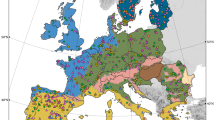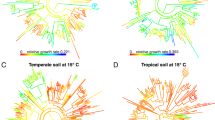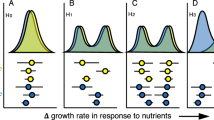Abstract
The high diversity of microbial communities hampers predictions about their responses to global change. Here we investigate the potential for using a phylogenetic, trait-based framework to capture the response of bacteria and fungi to global change manipulations. Replicated grassland plots were subjected to 3+ years of drought and nitrogen fertilization. The responses of leaf litter bacteria and fungi to these simulated changes were significantly phylogenetically conserved. Proportional changes in abundance were highly correlated among related organisms, such that relatives with approximately 5% ribosomal DNA genetic distance showed similar responses to the treatments. A microbe’s change in relative abundance was significantly correlated between the treatments, suggesting a compromise between numerical abundance in undisturbed environments and resistance to change in general, independent of disturbance type. Lineages in which at least 90% of the microbes shared the same response were circumscribed at a modest phylogenetic depth (τD 0.014–0.021), but significantly larger than randomized simulations predict. In several clades, phylogenetic depth of trait consensus was higher. Fungal response to drought was more conserved than was response to nitrogen fertilization, whereas bacteria responded equally to both treatments. Finally, we show that a bacterium’s response to the manipulations is correlated with its potential functional traits (measured here as the number of glycoside hydrolase genes encoding the capacity to degrade different types of carbohydrates). Together, these results suggest that a phylogenetic, trait-based framework may be useful for predicting shifts in microbial composition and functioning in the face of global change.
Similar content being viewed by others
Log in or create a free account to read this content
Gain free access to this article, as well as selected content from this journal and more on nature.com
or
References
Allison SD, Lu Y, Weihe C, Goulden ML, Martiny AC, Treseder KK et al.(2013). Microbial abundance and composition influence litter decomposition response to environmental change. Ecology 94: 714–725.
Allison SD, Martiny JBH . (2008). Colloquium paper: resistance, resilience, and redundancy in microbial communities. Proc Natl Acad Sci USA 105: 11512–11519.
Allison SD . (2012). A trait-based approach for modelling microbial litter decomposition. Ecol Lett 15: 1058–1070.
Amend AS, Barshis DJ, Oliver TA . (2012). Coral-associated marine fungi form novel lineages and heterogeneous assemblages. ISME J 6: 1291–1301.
Amend AS, Matulich KL, Martiny JB . (2015). Nitrogen addition, not initial phylogenetic diversity, increases litter decomposition by fungal communities. Front Microbiol 6: 109.
Anders S, Huber W . (2010). Differential expression analysis for sequence count data. Genome Biol 11: R106.
Barnard RL, Osborne CA, Firestone MK . (2013). Responses of soil bacterial and fungal communities to extreme desiccation and rewetting. ISME J 7: 2229–2241.
Beller HR, Han R, Karaoz U, Lim H, Brodie EL . (2012). Genomic and physiological characterization of the chromate-reducing, aquifer-derived Firmicute Pelosinus sp. strain HCF1. Appl Environ Microbiol 79: 63–73.
Berlemont R, Allison SD, Weihe C, Lu Y, Brodie EL, Martiny JB et al.(2014). Cellulolytic potential under environmental changes in microbial communities from grassland litter. Front Microbiol 5: 639.
Berlemont R, Martiny AC . (2013). Phylogenetic distribution of potential cellulases in bacteria. Appl Environ Microbiol 79: 1545–1554.
Berlemont R, Martiny AC . (2014). Genomic potential for polysaccharide deconstruction in bacteria. Appl Environ Microbiol 81: 1513–1519.
Blomberg SP, Garland T, Ives AR . (2003). Testing for phylogenetic signal in comparative data: behavioral traits are more labile. Evolution 57: 717–745.
Bruggeman J, Heringa J, Brandt BW . (2009). PhyloPars: estimation of missing parameter values using phylogeny. Nucleic Acids Res. 37: 179–184.
Cadotte MW, Cardinale BJ, Oakley TH . (2008). Evolutionary history and the effect of biodiversity on plant productivity. Proc Natl Acad Sci USA 105: 17012–17017.
Cadotte MW, Cavender-Bares J, Tilman D, Oakley TH . (2009). Using phylogenetic, functional and trait diversity to understand patterns of plant community productivity. PLoS One 4: e5695.
Caporaso JG, Kuczynski J, Stombaugh J, Bittinger K, Bushman FD, Costello EK et al.(2010). QIIME allows analysis of high-throughput community sequencing data. Nat Meth 7: 335–336.
Cornelissen JHC, van Bodegom PM, Aerts R, Callaghan TV, van Logtestijn RSP, Alatalo J et al.(2007). Global negative vegetation feedback to climate warming responses of leaf litter decomposition rates in cold biomes. Ecol Lett 10: 619–627.
Davis CC, Willis CG, Primack RB, Miller-Rushing AJ . (2010). The importance of phylogeny to the study of phenological response to global climate change. Phil Trans R Soc B Biol Sci 365: 3201–3213.
DeAngelis KM, Silver WL, Thompson AW, Firestone MK . (2010). Microbial communities acclimate to recurring changes in soil redox potential status. Environ Microbiol 12: 3137–3149.
Disz T, Akhter S, Cuevas D, Olson R, Overbeek R, Vonstein V et al.(2010). Accessing the SEED genome databases via Web services API: tools for programmers. BMC Bioinform 11: 319.
Doolittle WF . (1999). Phylogenetic classification and the universal tree. Science 284: 2124–2128.
Díaz S, Purvis A, Cornelissen JHC, Mace GM, Donoghue MJ, Ewers RM et al.(2013). Functional traits, the phylogeny of function, and ecosystem service vulnerability. Ecol Evol 3: 2958–2975.
Edgar RC, Haas BJ, Clemente JC, Quince C, Knight R . (2011). UCHIME improves sensitivity and speed of chimera detection. Bioinformatics 27: 2194–2200.
Edgar RC . (2010). Search and clustering orders of magnitude faster than BLAST. Bioinformatics 26: 2460–2461.
Evans SE, Wallenstein MD . (2014). Climate change alters ecological strategies of soil bacteria. Ecol Lett 17: 155–164.
Felsenstein J . (2005). PHYLIP—Phylogeny Inference Package version 3.6.
Fitzpatrick DA . (2012). Horizontal gene transfer in fungi. FEMS Microbiol Lett 329: 1–8.
Flynn DFB, Mirotchnick N, Jain M, Palmer MI, Naeem S . (2011). Functional and phylogenetic diversity as predictors of biodiversity—ecosystem-function relationships. Ecology 92: 1573–1581.
Freckleton RP, Harvey PH, Pagel M . (2002). Phylogenetic analysis and comparative data: a test and review of evidence. Am Nat 160: 712–726.
Garnier E, Cortez J, Billès G, Navas M-L, Roumet C, Debussche M et al.(2004). Plant functional markers capture ecosystem properties during secondary succession. Ecology 85: 2630–2637.
Harvey PH, Pagel MD . (1991) The Comparative Method in Evolutionary Biology. Oxford University Press: : Oxford.
Helmus MR, Keller WB, Paterson MJ, Yan ND, Cannon CH, Rusak JA . (2010). Communities contain closely related species during ecosystem disturbance. Ecol Lett 13: 162–174.
Ho LST, Ané C . (2014). A linear-time algorithm for Gaussian and non-Gaussian trait evolution models. Syst Biol 63: 397–408.
Katoh K, Asimenos G, Toh H . (2009). Multiple alignment of DNA sequences with MAFFT. Methods Mol Biol 537: 39–64.
Kembel SW, Cowan PD, Helmus MR, Cornwell WK, Morlon H, Ackerly DD et al.(2010). Picante: R tools for integrating phylogenies and ecology. Bioinformatics 26: 1463–1464.
Langille MGI, Zaneveld J, Caporaso JG, Mcdonald D, Knights D, Reyes JA et al.(2013). Predictive functional profiling of microbial communities using 16S rRNA marker gene sequences. Nat Biotechnol 31: 814–821.
Lavorel S, Garnier E . (2002). Predicting changes in community composition and ecosystem functioning from plant traits: revisiting the Holy Grail. Funct Ecology 16: 545–556.
Lennon JT, Aanderud ZT, Lehmkuhl BK, Schoolmaster DR . (2012). Mapping the niche space of soil microorganisms using taxonomy and traits. Ecology 93: 1867–1879.
Lu H, Chandran K, Stensel D . (2014). Microbial ecology of denitrification in biological wastewater treatment. Water Res 64: 237–254.
Martiny AC, Treseder K, Pusch G . (2013). Phylogenetic conservatism of functional traits in microorganisms. ISME J 7: 830–838.
Matulich KL, Martiny JBH . (2014). Microbial composition alters the response of litter decomposition to environmental change. Ecology 8: 154–163.
McGuire KL, Bent E, Borneman J, Majumder A, Allison SD, Treseder KK . (2010). Functional diversity in resource use by fungi. Ecology 91: 2324–2332.
Oksanen J, Blanchet FG, Kindt R, Legendre P, Minchin PR, O'Hara RB et al.(2013), Vegan: Community Ecology Package. R package version 2.0-7. Community ecology package version, 2, 0-7.
Paradis E, Claude J, Strimmer K . (2004). APE: analyses of phylogenetics and evolution in R language. Bioinformatics 20: 289–290.
Philippot L, Andersson SGE, Battin TJ, Prosser JI, Schimel JP, Whitman WB et al.(2010). The ecological coherence of high bacterial taxonomic ranks. Nat Rev Microbiol 8: 523–529.
Placella SA, Brodie EL, Firestone MK . (2012). Rainfall-induced carbon dioxide pulses result from sequential resuscitation of phylogenetically clustered microbial groups. Proc Natl Acad Sci USA 109: 10931–10936.
Saiya-Cork KR, Sinsabaugh RL, Zak DR . (2002). The effects of long term nitrogen deposition on extracellular enzyme activity in an Acer saccharum forest soil. Soil Biol Biochem 34: 1309–1315.
Snel B, Bork P, Huynen MA . (2002). Genomes in flux: the evolution of archaeal and proteobacterial gene content. Genome Res 12: 17–25.
Srivastava DS, Cadotte MW, MacDonald AAM, Marushia RG, Mirotchnick N . (2012). Phylogenetic diversity and the functioning of ecosystems. Ecol Lett 15: 637–648.
Stamatakis A, Hoover P, Rougemont J . (2008). A rapid bootstrap algorithm for the RAxML Web servers. Syst Biol 57: 758–771.
Sterner RW, Elser JJ . (2002) Ecological Stoichiometry: The Biology of Elements from Molecules to the Biosphere. Princeton University Press: Princeton, NJ, USA.
Suding KN, Lavorel S, CHAPIN FS, Cornelissen JHC, Díaz S, Garnier E et al.(2008). Scaling environmental change through the community-level: a trait-based response-and-effect framework for plants. Glob Chang Biol 14: 1125–1140.
Treseder KK, Maltz MR, Hawkins BA, Fierer N, Stajich JE, McGuire KL . (2014). Evolutionary histories of soil fungi are reflected in their large-scale biogeography. Ecol Lett 17: 1086–1093.
Violle C, Reich PB, Pacala SW, Enquist BJ, Kattge J . (2014). The emergence and promise of functional biogeography. Proc Natl Acad Sci USA 111: 13690–13696.
Wainwright PC . (2007). Functional versus morphological diversity in macroevolution. Annu Rev Ecol Evol Syst 38: 381–401.
Webb CO, Ackerly DD, Kembel SW . (2008). Phylocom: software for the analysis of phylogenetic community structure and trait evolution. Bioinformatics 24: 2098–2100.
Webb CO, Ackerly DD, McPeek MA, Donoghue MJ . (2002). Phylogenies and community ecology. Annu Rev Ecol Syst 33: 475–505.
Wellner A, Lurie MN, Gophna U . (2007). Complexity, connectivity, and duplicability as barriers to lateral gene transfer. Genome Biol 8: R156.
Williams NM, Crone EE, Roulston TH, Minckley RL, Packer L, Potts SG . (2010). Biological conservation. Biol Conserv 143: 2280–2291.
Willis CG, Ruhfel B, Primack RB, Miller-Rushing AJ, Davis CC . (2008). Phylogenetic patterns of species loss in Thoreau's woods are driven by climate change. Proc Natl Acad Sci USA 105: 17029–17033.
Zimmerman AE, Martiny AC, Allison SD . (2013). Microdiversity of extracellular enzyme genes among sequenced prokaryotic genomes. ISME J 7: 1187–1199.
Acknowledgements
We thank Kristin Matulich for technical and statistical assistance, the Orange County Parks and the Irvine Ranch Conservancy for site access, and Eoin Brodie and several anonymous reviewers for critical feedback. This study was support by a NOAA VSP climate change fellowship (ASA) and by the US Department of Energy, Office of Science, Office of Biological and Environmental Research (BER), under Award Number DE-PS02-09ER09-25 (ACM, SDA, MLG, KKT and JBHM).
Author Contributions
ASA, JBHM and ACM designed research; ASA, YL and CW performed research; ASA, RB and ACM analyzed data; and ASA, ACM, SDA, MLG, KKT and JBHM wrote the paper.
Author information
Authors and Affiliations
Corresponding author
Ethics declarations
Competing interests
The authors declare no conflict of interest.
Additional information
Supplementary Information accompanies this paper on The ISME Journal website
Supplementary information
Rights and permissions
About this article
Cite this article
Amend, A., Martiny, A., Allison, S. et al. Microbial response to simulated global change is phylogenetically conserved and linked with functional potential. ISME J 10, 109–118 (2016). https://doi.org/10.1038/ismej.2015.96
Received:
Revised:
Accepted:
Published:
Issue date:
DOI: https://doi.org/10.1038/ismej.2015.96
This article is cited by
-
Land management shapes drought responses of dominant soil microbial taxa across grasslands
Nature Communications (2024)
-
Plant property regulates soil bacterial community structure under altered precipitation regimes in a semi-arid desert grassland, China
Journal of Arid Land (2023)
-
Nitrate has a stronger rhizobacterial-based effect on rice growth and nitrogen use than ammonium in acidic paddy soil
Plant and Soil (2023)
-
Genomic profiling of Nitrospira species reveals ecological success of comammox Nitrospira
Microbiome (2022)
-
Long-Term Drought and Warming Alter Soil Bacterial and Fungal Communities in an Upland Heathland
Ecosystems (2022)



